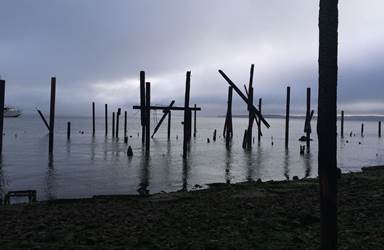| |
| |
E-Mail Forum – 2016 |
|
| |
< RETURN |
|
| |
Pilot Project to Remove 350 Creosote-Treated Pilings from San Pablo Bay
November 17, 2016 |
|
|
| Pilot Project to Remove 350 Creosote-Treated Pilings from San Pablo Bay
by Victoria Schlesinger on November 04, 2016

Creosote-treated pilings at the Red Rocks warehouse site in Richmond. (Photo by Marilyn Latta, State Coastal Conservancy)
An estimated 33,000 creosote-treated pilings stand—or, more often, partially stand—along the shore of the Bay, leaching toxins into the water that cause birth deformities in Pacific herring. The pilings are the derelict remnants of piers, wharves, warehouses, and more from as long ago as the 1800s. Starting this fall and continuing in to the winter, California’s State Coastal Conservancy (SCC) will remove the first batch of pilings from the San Pablo Bay shoreline just north of Point San Pablo in Richmond.
The pilot project will remove 350 pilings and a collapsing creosote-treated deck adjacent to the old Red Rock warehouse, which was built in 1938. The site was chosen based on various criteria, among them the potential for successfully restoring eelgrass and other native habitats there, as well as providing structures for spawning Pacific herring.
According to Bodega Marine Laboratory studies, when herring lay their eggs on the creosote pilings, as opposed to another hard structure, the offspring die or are deformed from exposure to the hundreds of chemical compounds found in the petroleum byproduct. Pacific herring are important to the Bay ecosystem and local fisheries. Improving their habitat in the Bay is part of the San Francisco Bay Subtidal Habitat Goals, set by regional agencies in 2011 in an effort to restore the health of the Bay and its native species.
Once the pilings and debris are removed, they’ll be dried and disposed of in landfills for non-hazardous waste. Restoration work at Point San Pablo will begin after the spawning season in the spring of 2017, and include experimenting with different structures and native plantings. “We’re learning about the best approach for subtidal restoration,” says Marilyn Latta, project manager with the SCC. “There’s a large team that’s worked on living shorelines, and we’re gaining firsthand knowledge by testing it out.”
The $2 million pilot project, supported by a grant from the National Fish and Wildlife Foundation, is the first of what the SCC and partners hope will be many such removal and restoration projects. Already in the planning stage is a site with 2,500 pilings at the Terminal 4 wharf in Richmond, not far from the Red Rock warehouse project. |
|
| |
< RETURN |
|
|

